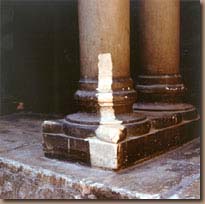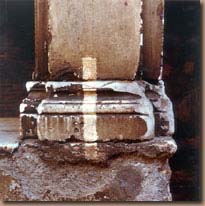Conservation treatment
The restoration of the columns, slabs and pilasters presents considerable difficulties.
The numerous cleaning tests have ascertained that traditional poultices have not provided consistent results precisely due to the presence of these coating layers. Better results have been obtained using laser treatment that also has the advantage of being able to operate on deteriorated supports without prior consolidation, as the beam emitted from the instrument is absorbed by the surface dirt, which is removed without damaging the underlying stone, even if the latter lacks cohesion.
The other advantage is that it does not create any form of abrasion in that the rays, depending on their speed of emission, cause the ‘vaporization’ of the deposits.
After cleaning it will be possible to evaluate more precisely the state of the stone material and the effective capacity of the fillings and come to decisions as to their conservation. Some are in fact the result of recent treatments carried out with inadequate care that have impaired the overall appearance.
The proposed treatments are as follows:
Preventive treatment with biocides (preventol) to be carried out several times at intervals some days before continuing any further treatment.
Laser cleaning of the surfaces which, given the diverse nature of the materials, will take place after testing small sample patches to be able to gauge the final color outcome.
Removal of iron oxide stains from the stone surface.
Removal of residual concretions with micro-drills and scalpels.
Replacement of incoherent cement fillings and repair of decayed portions with specially tested mortars varying from one case to the next so that they blend in with the overall appearance.
Consolidation of cracks in the stone material with acrylic resins after first sealing any possible exit points with slaked lime mortar and inert aggregates compatible with the base material followed by final sealing of the inlet points.
Micro-fillings in cases of microfractures of the lapidary material, carried out with a mortar of slaked lime and marble dust, previously tested to ensure its suitability both in grain size and color.
Watercolor coating with stable pigments of the chromatically uneven points of intervention.
Application of ethyl silicate by brush up to saturation point in order to consolidate the areas where phenomena of disintegration are present.
Protection of surfaces with silicon resin.
|
© 1999 Coordination
Monica Morbidelli |

